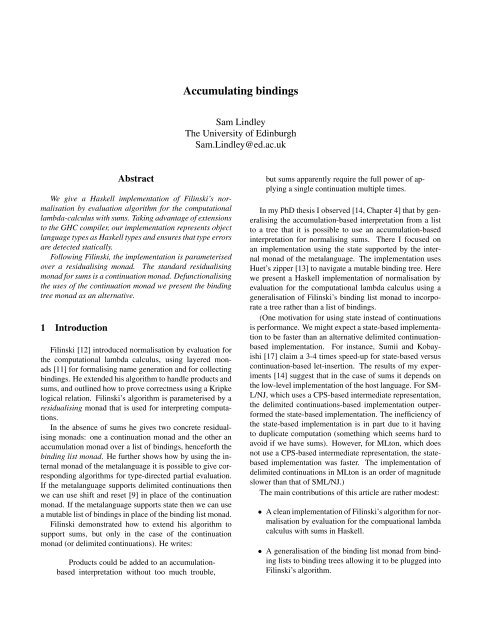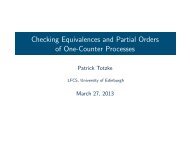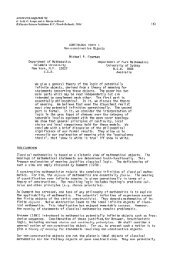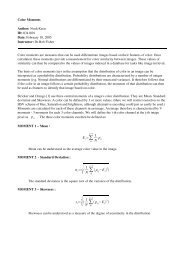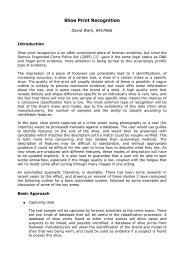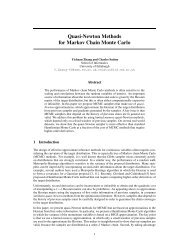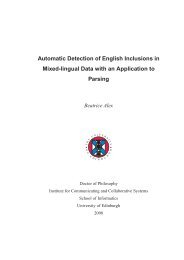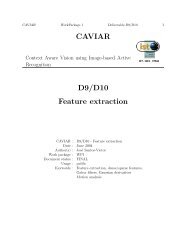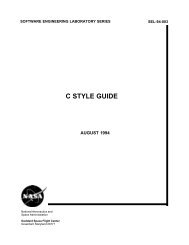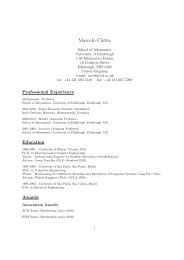Accumulating bindings - University of Edinburgh
Accumulating bindings - University of Edinburgh
Accumulating bindings - University of Edinburgh
Create successful ePaper yourself
Turn your PDF publications into a flip-book with our unique Google optimized e-Paper software.
<strong>Accumulating</strong> <strong>bindings</strong><br />
Sam Lindley<br />
The <strong>University</strong> <strong>of</strong> <strong>Edinburgh</strong><br />
Sam.Lindley@ed.ac.uk<br />
Abstract<br />
We give a Haskell implementation <strong>of</strong> Filinski’s normalisation<br />
by evaluation algorithm for the computational<br />
lambda-calculus with sums. Taking advantage <strong>of</strong> extensions<br />
to the GHC compiler, our implementation represents object<br />
language types as Haskell types and ensures that type errors<br />
are detected statically.<br />
Following Filinski, the implementation is parameterised<br />
over a residualising monad. The standard residualising<br />
monad for sums is a continuation monad. Defunctionalising<br />
the uses <strong>of</strong> the continuation monad we present the binding<br />
tree monad as an alternative.<br />
1 Introduction<br />
Filinski [12] introduced normalisation by evaluation for<br />
the computational lambda calculus, using layered monads<br />
[11] for formalising name generation and for collecting<br />
<strong>bindings</strong>. He extended his algorithm to handle products and<br />
sums, and outlined how to prove correctness using a Kripke<br />
logical relation. Filinski’s algorithm is parameterised by a<br />
residualising monad that is used for interpreting computations.<br />
In the absence <strong>of</strong> sums he gives two concrete residualising<br />
monads: one a continuation monad and the other an<br />
accumulation monad over a list <strong>of</strong> <strong>bindings</strong>, henceforth the<br />
binding list monad. He further shows how by using the internal<br />
monad <strong>of</strong> the metalanguage it is possible to give corresponding<br />
algorithms for type-directed partial evaluation.<br />
If the metalanguage supports delimited continuations then<br />
we can use shift and reset [9] in place <strong>of</strong> the continuation<br />
monad. If the metalanguage supports state then we can use<br />
a mutable list <strong>of</strong> <strong>bindings</strong> in place <strong>of</strong> the binding list monad.<br />
Filinski demonstrated how to extend his algorithm to<br />
support sums, but only in the case <strong>of</strong> the continuation<br />
monad (or delimited continuations). He writes:<br />
Products could be added to an accumulationbased<br />
interpretation without too much trouble,<br />
but sums apparently require the full power <strong>of</strong> applying<br />
a single continuation multiple times.<br />
In my PhD thesis I observed [14, Chapter 4] that by generalising<br />
the accumulation-based interpretation from a list<br />
to a tree that it is possible to use an accumulation-based<br />
interpretation for normalising sums. There I focused on<br />
an implementation using the state supported by the internal<br />
monad <strong>of</strong> the metalanguage. The implementation uses<br />
Huet’s zipper [13] to navigate a mutable binding tree. Here<br />
we present a Haskell implementation <strong>of</strong> normalisation by<br />
evaluation for the computational lambda calculus using a<br />
generalisation <strong>of</strong> Filinski’s binding list monad to incorporate<br />
a tree rather than a list <strong>of</strong> <strong>bindings</strong>.<br />
(One motivation for using state instead <strong>of</strong> continuations<br />
is performance. We might expect a state-based implementation<br />
to be faster than an alternative delimited continuationbased<br />
implementation. For instance, Sumii and Kobayishi<br />
[17] claim a 3-4 times speed-up for state-based versus<br />
continuation-based let-insertion. The results <strong>of</strong> my experiments<br />
[14] suggest that in the case <strong>of</strong> sums it depends on<br />
the low-level implementation <strong>of</strong> the host language. For SM-<br />
L/NJ, which uses a CPS-based intermediate representation,<br />
the delimited continuations-based implementation outperformed<br />
the state-based implementation. The inefficiency <strong>of</strong><br />
the state-based implementation is in part due to it having<br />
to duplicate computation (something which seems hard to<br />
avoid if we have sums). However, for MLton, which does<br />
not use a CPS-based intermediate representation, the statebased<br />
implementation was faster. The implementation <strong>of</strong><br />
delimited continuations in MLton is an order <strong>of</strong> magnitude<br />
slower than that <strong>of</strong> SML/NJ.)<br />
The main contributions <strong>of</strong> this article are rather modest:<br />
• A clean implementation <strong>of</strong> Filinski’s algorithm for normalisation<br />
by evaluation for the compuational lambda<br />
calculus with sums in Haskell.<br />
• A generalisation <strong>of</strong> the binding list monad from binding<br />
lists to binding trees allowing it to be plugged into<br />
Filinski’s algorithm.
2 Implementation<br />
Danvy et al [10] give an implementation <strong>of</strong> normalisation<br />
by evaluation for call-by-name simply-typed lambdacalculus<br />
in Haskell. Input terms are represented as<br />
closed Haskell expressions. The type-indexed reify and<br />
reflect functions are written as instances <strong>of</strong> a type class.<br />
The output terms are represented as typed higher-order abstract<br />
syntax terms in normal form. As the types and structure<br />
<strong>of</strong> normal forms are enforced by the Haskell type system<br />
they can be sure that their algorithm: a) preserves typing<br />
and b) outputs normal forms.<br />
In this section we use some similar ideas, but our goals<br />
are slightly different. Our implementation is for call-byvalue<br />
computational lambda-calculus with sums. Our implementation<br />
takes typed HOAS as input and outputs FOAS<br />
terms in normal form. We use a GADT in conjunction with<br />
a type class in order to explicitly represent Haskell types as<br />
terms. Thus we can leverage the Haskell type checker to<br />
statically check that the input term is well-typed and that its<br />
type matches up with the input type explicitly supplied to<br />
the normalisation function. As in the Danvy et al’s implementation,<br />
it is necessary to explicitly write the type <strong>of</strong> the<br />
term being normalised somewhere, as the type Haskell will<br />
infer will be polymorphic, whereas our object language is<br />
monomorphic.<br />
The full Haskell source is available at the following<br />
URL: http://homepages.inf.ed.ac.uk/slindley/<br />
nbe/nbe-sums.hs.<br />
We begin by defining an algebraic datatype for representing<br />
computational lambda calculus terms extended with<br />
sums.<br />
type Var = String<br />
data Exp = Var Var<br />
| Lam Var Exp<br />
| App Exp Exp<br />
| Inl Exp<br />
| Inr Exp<br />
| Case Exp Var Exp Var Exp<br />
| Let Var Exp Exp<br />
We use the Haskell String type to represent variables.<br />
Terms are constructed from variables, lambda, application,<br />
left injection, right injection, case and let. As Filinski remarks,<br />
let is redundant; it is included in order to give nicer<br />
normal forms. We chose not to include products in the presentation<br />
because there is little <strong>of</strong> interest to say about them<br />
and it is straightforward to add them.<br />
The first-order Exp datatype is rather a verbose way<br />
<strong>of</strong> writing syntax and makes no guarantees about binding.<br />
We choose to use higher-order abstract syntax as our input<br />
syntax, which automatically restricts us to closed terms<br />
and makes use <strong>of</strong> Haskell’s built-in binding. Following<br />
Carette et al [8] we use a type class, relying on parametricity<br />
to exclude so-called “exotic terms” [5].<br />
class CompLam exp where<br />
lam :: (exp → exp) → exp<br />
app :: exp → exp → exp<br />
inl :: exp → exp<br />
inr :: exp → exp<br />
case_ ::<br />
exp → (exp → exp) → (exp → exp) → exp<br />
let_ :: exp → (exp → exp) → exp<br />
type Hoas = ∀exp . CompLam exp ⇒ exp<br />
Following Atkey et al [6] it is straightforward to convert<br />
from the HOAS representation to the FOAS representation<br />
by defining a suitable instance <strong>of</strong> the CompLam type class.<br />
hoasToExp :: Hoas → Exp<br />
hoasToExp v = evalGen v 0<br />
instance CompLam (Gen Exp) where<br />
lam f = do x ← nextName<br />
e ← f (return (Var x))<br />
return$ Lam x e<br />
v1 ‘app‘ v2 = do e1 ← v1<br />
e2 ← v2<br />
return$ App e1 e2<br />
inl v = do e ← v<br />
return$ Inl e<br />
inr v = do e ← v<br />
return$ Inr e<br />
case_ v l r = do e ← v<br />
x1 ← nextName<br />
x2 ← nextName<br />
e1 ← l (return (Var x1))<br />
e2 ← r (return (Var x2))<br />
return$ Case e x1 e1 x2 e2<br />
let_ v f = do e ← v<br />
x ← nextName<br />
e’ ← f (return (Var x))<br />
return$ Let x e e’<br />
Instead <strong>of</strong> outputting a de Bruijn representation, here we<br />
choose to use a name generation monad, targetting a representation<br />
with explicit names in order to fit in with Filinski’s<br />
monadic treatment <strong>of</strong> names.<br />
type Gen = State Int<br />
nextName :: Gen Var<br />
nextName =<br />
do { i ← get; put (i+1); return ("x" ++ show i) }<br />
evalGen :: Gen a → Int → a<br />
evalGen = evalState<br />
The simple types <strong>of</strong> our source language are given by the<br />
grammar<br />
σ, τ ::= A | B | C | σ → τ | σ + τ<br />
2
where A, B, C are abstract base types. In Haskell, for +<br />
we write ⊕ (in order to avoid clashing with the built-in +)<br />
which is syntactic sugar for the Either datatype.<br />
data A<br />
data B<br />
data C<br />
type a ⊕ b = Either a b<br />
Following Atkey et al [6], we define a GADT Rep<br />
<strong>of</strong> representations <strong>of</strong> simple types along with a typeclass<br />
Representable a which allows us to smoothly bridge<br />
the gap between Haskell types and object language type representations.<br />
data Rep :: ⋆ → ⋆ where<br />
A :: Rep A<br />
B :: Rep B<br />
C :: Rep C<br />
() :: Rep a → Rep b → Rep (a → b)<br />
(⊕) :: Rep a → Rep b → Rep (a ⊕ b)<br />
class Representable a where<br />
rep :: Rep a<br />
instance Representable A where rep = A<br />
instance Representable B where rep = B<br />
instance Representable C where rep = C<br />
instance (Representable a, Representable b) ⇒<br />
Representable (a → b) where<br />
rep = rep rep<br />
instance (Representable a, Representable b) ⇒<br />
Representable (a ⊕ b) where<br />
rep = rep ⊕ rep<br />
For instance, we can now write down a Haskell term representing<br />
the type<br />
as<br />
((A → B) → A) → A<br />
rep :: Rep (((A → B) → A) → A)<br />
Note that the Representable type class is closed by<br />
construction, as the Rep GADT only admits simple type<br />
representations.<br />
2.1 Residualising monads<br />
Filinski’s algorithm is parameterised by a monad, called<br />
a residualising monad. The idea is that a residualising<br />
monad will be used to interpret computations and that it<br />
must contain enough hooks in order to allow us to recover<br />
syntax from the semantics. Filinski gives a fairly abstract<br />
characteration <strong>of</strong> residualising monads in terms <strong>of</strong> several<br />
operations. We capture his notion via a typeclass <strong>of</strong> residualising<br />
monads.<br />
class Monad m ⇒ Residualising m where<br />
gamma :: Gen a → m a<br />
collect :: m Exp → Gen Exp<br />
bind :: Exp → m Var<br />
binds :: Exp → m (Var ⊕ Var)<br />
Filinski assumes that a residualising monad is layered<br />
atop [11] a name generation monad.<br />
The gamma operation is a monad morphism lifting a<br />
computation <strong>of</strong> type a in the name generation monad to a<br />
computation <strong>of</strong> type a in the residualising monad.<br />
The bind and binds operations respectively introduce<br />
let and case <strong>bindings</strong>, by storing the bound term and returning<br />
its name inside the residualising monad.<br />
The collect operation collects all the <strong>bindings</strong> from<br />
the residualising monad.<br />
The collect, bind and binds operations must satisfy<br />
the following equations.<br />
collect (return e) = return e<br />
collect (bind e>>=f) =<br />
do x ← nextName<br />
e’ ← collect (f x)<br />
return (Let x e e’)<br />
collect (binds e>>=f) =<br />
do x1 ← nextName<br />
x2 ← nextName<br />
e1 ← collect (f (Left x1))<br />
e2 ← collect (f (Right x2))<br />
return (Case e x1 e1 x2 e2)<br />
These equations give a rather direct correspondence between<br />
the syntactic and semantic representations <strong>of</strong> <strong>bindings</strong>.<br />
One can construct a tree <strong>of</strong> <strong>bindings</strong> in the semantics<br />
using bind, binds, >>= and return, and then reify it<br />
as syntax. For instance:<br />
collect (do s ← binds e<br />
case s <strong>of</strong><br />
Left x1 →<br />
do z ← bind e’; return (Var z)<br />
Right x2 → return (Var x2))<br />
=<br />
do x1 ← nextName<br />
x2 ← nextName<br />
z ← nextName<br />
return (Case e x1 (Let z e’ (Var z)) x2 (Var x2))<br />
2.2 A monadic evaluator<br />
The evaluator is a standard evaluator for the computational<br />
lambda-calculus parameterised by a monad as well<br />
as operations for boxing and unboxing functions and sums.<br />
In order to perform normalisation by evaluation we instantiate<br />
it with a residualising monad.<br />
type Env a = [(Var, a)]<br />
3
empty :: Env a<br />
empty = []<br />
extend :: [(Var, a)] → Var → a → [(Var, a)]<br />
extend env x v = (x, v):env<br />
class FunInt v m where<br />
injFun :: (v → m v) → m v<br />
projFun :: v → (v → m v)<br />
class SumInt v where<br />
injSum :: v ⊕ v → v<br />
projSum :: v → v ⊕ v<br />
eval ::<br />
(Monad m, FunInt a m, SumInt a) ⇒<br />
Env a → Exp → m a<br />
eval env (Var x) =<br />
return (fromJust (lookup x env))<br />
eval env (Lam x e) =<br />
injFun (λv → eval (extend env x v) e)<br />
eval env (App e1 e2) =<br />
do<br />
v1 ← eval env e1<br />
v2 ← eval env e2<br />
projFun v1 v2<br />
eval env (Let x e1 e2) =<br />
do<br />
v ← eval env e1<br />
eval (extend env x v) e2<br />
eval env (Inl e) =<br />
do<br />
v ← eval env e<br />
return (injSum (Left v))<br />
eval env (Inr e) =<br />
do<br />
v ← eval env e<br />
return (injSum (Right v))<br />
eval env (Case e x1 e1 x2 e2) =<br />
do<br />
v ← eval env e<br />
case projSum v <strong>of</strong><br />
Left v → eval (extend env x1 v) e1<br />
Right v → eval (extend env x2 v) e2<br />
2.3 The normalisation function<br />
We define the semantics in Haskell using a datatype<br />
SemV m for values and a datatype SemC m for computations.<br />
The parameter m is the residualising monad.<br />
data SemV m = Neutral Exp<br />
| Fun (SemV m → SemC m)<br />
| Sum (SemV m ⊕ SemV m)<br />
type SemC m = m (SemV m)<br />
Base types are interpreted as expressions, functions as<br />
Haskell functions from values to computations, and sums<br />
using the Haskell Either datatype. Computations are interpreted<br />
in the residualising monad. The boxing and unboxing<br />
functions are straightforward.<br />
instance Residualising m ⇒ FunInt (SemV m) m where<br />
injFun f = return (Fun f)<br />
projFun = λ(Fun f) → f<br />
instance Residualising m ⇒ SumInt (SemV m) where<br />
injSum = Sum<br />
projSum = λ(Sum s) → s<br />
Each residualising monad m gives rise to a residualising<br />
evaluator.<br />
type ResEval m = Env (SemV m) → Exp → SemC m<br />
Having pinned down the interpretation, we now need to<br />
define a function reifyC mapping semantic computations<br />
to syntactic normal forms. The reifyC function is typeindexed.<br />
The supplied computation is run inside the residualising<br />
monad, binding the result to a value which is reified<br />
as an expression with the function reifyV lifted into the<br />
residualising monad by gamma. Any <strong>bindings</strong> that are generated<br />
are collected through the collect function.<br />
reifyC ::<br />
Residualising m ⇒ Rep a → SemC m → Gen Exp<br />
reifyC a c = collect (do v ← c; gamma (reifyV a v))<br />
The reifyV function (in conjunction with its partner,<br />
the reflectV function) does most <strong>of</strong> the actual work. It<br />
follows the usual pattern for normalisation by evaluation.<br />
On base types it is the identity (modulo unboxing and lifting<br />
into the name generation monad). On functions it generates<br />
a fresh name for a lambda expression that is reflected as a<br />
value and fed into the function before reifying the result.<br />
On sums it does a case split on the supplied value, reifying<br />
at the appropriate type according to whether it is a left or a<br />
right injection.<br />
reifyV ::<br />
Residualising m ⇒ Rep a → SemV m → Gen Exp<br />
reifyV A (Neutral e) = return e<br />
reifyV B (Neutral e) = return e<br />
reifyV C (Neutral e) = return e<br />
reifyV (a b) (Fun f) =<br />
do x ← nextName<br />
e ← reifyC b (do v ← reflectV a x; f v)<br />
return$ Lam x e<br />
reifyV (a ⊕ b) (Sum (Left v)) =<br />
do e ← reifyV a v<br />
return$ Inl e<br />
reifyV (a ⊕ b) (Sum (Right v)) =<br />
do e ← reifyV b v<br />
return$ Inr e<br />
As the body <strong>of</strong> a function in the semantics is a computation,<br />
we call reifyC here instead <strong>of</strong> reifyV.<br />
4
Of course, we also need to define the function<br />
reflectV for reflecting neutral expressions as semantics.<br />
In fact, the only neutral value expressions we have are variables,<br />
so we specialise the type <strong>of</strong> reflectV to take a<br />
variable rather than an expression. Again reflectV follows<br />
the usual pattern for normalisation by evaluation. At<br />
base types it gives the variable itself. At function types it<br />
gives a function that returns the result <strong>of</strong> reflecting the input<br />
variable applied to the reified argument <strong>of</strong> the function.<br />
At sum type it calls binds on the input variable and then<br />
performs a case split reflecting at the appropriate type according<br />
to whether the value bound by binds is a left or a<br />
right injection.<br />
reflectV ::<br />
Residualising m ⇒ Rep a → Var → SemC m<br />
reflectV A x = return (Neutral (Var x))<br />
reflectV B x = return (Neutral (Var x))<br />
reflectV C x = return (Neutral (Var x))<br />
reflectV (a b) x =<br />
return (Fun (λv → do e ← gamma (reifyV a v)<br />
reflectC b x e))<br />
reflectV (a ⊕ b) x =<br />
do v ← binds (Var x)<br />
case v <strong>of</strong><br />
Left x1 →<br />
do v1 ← reflectV a x1<br />
return (Sum (Left v1))<br />
Right x2 →<br />
do v2 ← reflectV b x2<br />
return (Sum (Right v2))<br />
For the body <strong>of</strong> a function we need to reflect a computation<br />
expression in the form <strong>of</strong> a variable applied to an expression.<br />
The reflectC function binds the application<br />
before calling reflectV on the resulting variable.<br />
reflectC ::<br />
Residualising m ⇒ Rep a → Var → Exp → SemC m<br />
reflectC a x e =<br />
do x ← bind (App (Var x) e)<br />
reflectV a x<br />
We are now in a position to define a normalisation function.<br />
normU ::<br />
Residualising m ⇒<br />
ResEval m → Rep a → Hoas → Exp<br />
normU eval a e =<br />
evalGen (reifyC a (eval empty (hoasToExp e))) 0<br />
The function normU takes a residualising evaluator, a type<br />
and a HOAS term, and returns a FOAS term in normal form.<br />
The first argument is a hack to allow us to choose different<br />
residualising monads at run-time. We will always pass in<br />
the same eval function, but with a different type annotation<br />
in order to tell GHC which residualising monad to use.<br />
2.4 Two residualising monads<br />
Filinski gives two residualising monads for the computational<br />
lambda-calculus without sums: a continuation monad<br />
with answer type Gen Exp and an accumulation monad<br />
over lists <strong>of</strong> let <strong>bindings</strong>, with name generation layered atop<br />
it.<br />
He shows how to use the former to handle sums. Here,<br />
we also show how to generalise the latter to handle sums.<br />
The continuation monad The continuation monad is<br />
built into Haskell. We just need to instantiate it at the appropriate<br />
answer type, and then define the residualising operations.<br />
type ContGenExp = Cont (Gen Exp)<br />
instance Residualising ContGenExp where<br />
gamma f = Cont (λk → do m ← f; k m)<br />
collect (Cont f) = f return<br />
bind e =<br />
Cont (λk →<br />
do x ← nextName<br />
e’ ← k x<br />
return (Let x e e’))<br />
binds e =<br />
Cont (λk →<br />
do x1 ← nextName<br />
x2 ← nextName<br />
e1 ← k (Left x1)<br />
e2 ← k (Right x2)<br />
return (Case e x1 e1 x2 e2))<br />
The binding tree monad The datatype underlying Filinski’s<br />
binding list monad can be expressed in Haskell as follows.<br />
data Acc’ a = Val a<br />
| LetB Var Exp (Acc’ a)<br />
This encodes a binding list (<strong>of</strong> let <strong>bindings</strong>) alongside a<br />
value <strong>of</strong> type a.<br />
In order to extend Acc’ to handle sums we need to accumulate<br />
trees rather than lists <strong>of</strong> <strong>bindings</strong>. The tree structure<br />
arises from case <strong>bindings</strong> which bind one variable for each<br />
<strong>of</strong> the two branches <strong>of</strong> a case. Rather than accumulating a<br />
binding list alongside a single value, we now accumulate a<br />
binding tree alongside a list <strong>of</strong> values — one for each leaf<br />
<strong>of</strong> the tree.<br />
data Acc a = Val a<br />
| LetB Var Exp (Acc a)<br />
| CaseB Exp Var (Acc a) Var (Acc a)<br />
The nodes <strong>of</strong> the tree are let and case <strong>bindings</strong> and the<br />
leaves are values. It is now straightforward to define a<br />
monad instance for Acc.<br />
5
instance Monad Acc where<br />
return v = Val v<br />
Val v>>=f = f v<br />
LetB x e m>>=f =<br />
LetB x e (m>>=f)<br />
CaseB e x1 m1 x2 m2>>=f =<br />
CaseB e x1 (m1>>=f) x2 (m2>>=f)<br />
The >>= operator is recursively defined over the continuations<br />
<strong>of</strong> each binding. The operation t >>= f simply<br />
descends to the leaves replacing each leaf Val v with the<br />
tree f v.<br />
It is worth noting that both the binding list monad and<br />
the binding tree monad are free monads [18]. The former is<br />
the free monad over the functor underlying the datatype:<br />
data L a = LetL Var Exp a<br />
and the latter is the free monad over the functor underlying<br />
the datatype:<br />
data T a = LetT Var Exp a<br />
| CaseT Exp Var a Var a<br />
The connection with free monads is unsurprising given that<br />
NBE hinges on including enough syntactic hooks in a denotational<br />
semantics, and free monads constitute prototypical<br />
“syntactic” monads.<br />
If the values at the leaves <strong>of</strong> a tree are expressions, then<br />
we can flatten the tree to a single expression.<br />
flatten :: Acc Exp → Exp<br />
flatten (Val e) = e<br />
flatten (LetB x e t) = Let x e (flatten t)<br />
flatten (CaseB v x1 t1 x2 t2) =<br />
Case v x1 (flatten t1) x2 (flatten t2)<br />
In order to obtain a residualising monad we layer the<br />
name generation monad atop the binding tree monad.<br />
newtype GenAcc a = GA {unGA :: Gen (Acc a)}<br />
instance Monad GenAcc where<br />
return = GA . return . return<br />
m>>=k =<br />
GA (do c ← unGA m<br />
case c <strong>of</strong><br />
Val v → unGA (k v)<br />
LetB x e m →<br />
do t ← unGA (GA (return m)>>=k)<br />
return (LetB x e t)<br />
CaseB e x1 m1 x2 m2 →<br />
do t1 ← unGA (GA (return m1)>>=k)<br />
t2 ← unGA (GA (return m2)>>=k)<br />
return (CaseB e x1 t1 x2 t2))<br />
Now we can define the residualising operations.<br />
instance Residualising GenAcc where<br />
gamma f = GA (do v ← f; return (return v))<br />
collect (GA f) = do t ← f<br />
return (flatten t)<br />
bind e =<br />
GA (do x ← nextName<br />
return$ LetB x e (Val x))<br />
binds e =<br />
GA (do x1 ← nextName<br />
x2 ← nextName<br />
return$ CaseB e x1 (Val (Left x1))<br />
x2 (Val (Left x2)))<br />
Notice the similarity between these definitions and those<br />
for the continuation monad. In essence they do the same<br />
thing. Where the continuation monad manipulates <strong>bindings</strong><br />
implicitly using functional continuations, the binding<br />
tree monad manipulates them explicitly using a binding tree<br />
data structure. The binding tree is really just a defunctionalised<br />
[16] version <strong>of</strong> the continuation monad.<br />
Having defined two residualising monads we are now in<br />
a position to instantiate our normalisation function with either<br />
<strong>of</strong> them:<br />
normAccU = normU (eval :: ResEval GenAcc)<br />
normContU = normU (eval :: ResEval ContGenExp)<br />
Examples<br />
> normAccU (rep :: Rep (A → A)) (lam (λx → x))<br />
λx0 → x0<br />
> normContU (rep :: Rep (A → A)) (lam (λx → x))<br />
λx0 → x0<br />
> normAccU<br />
(rep :: Rep (A ⊕ B → A ⊕ B))<br />
(lam (λx → x))<br />
λx0 → case x0 <strong>of</strong><br />
Left x1 → Left x1;<br />
Right x2 → Right x2<br />
> normContU<br />
(rep :: Rep ((A ⊕ (B → C)) → (A ⊕ (B → C))))<br />
(lam (λx → x))<br />
λx0 → case x0 <strong>of</strong><br />
Left x1 → Left x1;<br />
Right x2 →<br />
Right (λx3 → let x4 = x2 x3 in x4)<br />
Unfortunately type errors are manifested as runtime errors:<br />
> normAccU<br />
(rep :: Rep (A → B → A))<br />
(lam (λx → x))<br />
λx0 → ⋆⋆⋆ Exception: tacc.hs:(306,0)-(318,19):<br />
Non-exhaustive patterns in function reifyV<br />
> normAccU<br />
(rep :: Rep (A → A))<br />
(lam (λx → app x x))<br />
λx0 → ⋆⋆⋆ Exception: tacc.hs:361:14-26:<br />
Non-exhaustive patterns in lambda<br />
6
Fortunately, it is easy to do better.<br />
2.5 Static typing<br />
Though we have successfully demonstrated how to use a<br />
Haskell type as the argument to the normalisation function<br />
our current implementation does not check either that the<br />
input term is well-typed or that the supplied type matches<br />
up with the type <strong>of</strong> the input term, whose representation is<br />
untyped.<br />
Following Atkey et al [6], we augment our HOAS representation<br />
with type information, taking advantage <strong>of</strong> parametricity<br />
and our encoding <strong>of</strong> representable types to preclude<br />
“exotic types”.<br />
class TCompLam exp where<br />
tlam :: (Representable a, Representable b) ⇒<br />
(exp a → exp b) → exp (a → b)<br />
tapp :: (Representable a, Representable b) ⇒<br />
exp (a → b) → exp a → exp b<br />
tinl :: (Representable a, Representable b) ⇒<br />
exp a → exp (a ⊕ b)<br />
tinr :: (Representable a, Representable b) ⇒<br />
exp b → exp (a ⊕ b)<br />
tcase :: (Representable a, Representable b,<br />
Representable c) ⇒<br />
exp (a ⊕ b) → (exp a → exp c) →<br />
(exp b → exp c) → exp c<br />
tlet :: (Representable a, Representable b) ⇒<br />
exp a → (exp a → exp b) → exp b<br />
type THoas a =<br />
∀(exp :: ⋆ → ⋆) . TCompLam exp ⇒ exp a<br />
For now, our goal is to ensure that the type <strong>of</strong> the representation<br />
passed to the normalisation function matches up<br />
with the type <strong>of</strong> the HOAS input term. We are not attempting<br />
to use the Haskell type system to enforce well-typedness<br />
<strong>of</strong> the resulting FOAS representation.<br />
(It may be possible to push the types further. Atkey [3]<br />
has made some progress in adapting the code from this article<br />
to take typed HOAS terms to typed HOAS terms in<br />
normal form, along the lines <strong>of</strong> Danvy et al [10]. His solution<br />
relies on making a syntactic distinction between value<br />
expressions and computation expressions and a somewhat<br />
more complicated datatype for higher-order abstract syntax.)<br />
Thus we instantiate TCompLam with a newtype that<br />
simply forgets its type argument.<br />
thoasToExp :: THoas a → Exp<br />
thoasToExp v = evalGen (unT v) 0<br />
newtype T a = T {unT :: Gen Exp}<br />
instance TCompLam T where<br />
tlam f = T$<br />
do x ← nextName<br />
e ← unT$ f (T$ return (Var x))<br />
return (Lam x e)<br />
v1 ‘tapp‘ v2 = T$<br />
do e1 ← unT v1<br />
e2 ← unT v2<br />
return (App e1 e2)<br />
tinl v = T$<br />
do e ← unT v<br />
return (Inl e)<br />
tinr v = T$<br />
do e ← unT v<br />
return (Inr e)<br />
tcase v l r = T$<br />
do e ← unT v<br />
x1 ← nextName<br />
x2 ← nextName<br />
e1 ← unT$ l (T$ return (Var x1))<br />
e2 ← unT$ r (T$ return (Var x2))<br />
return (Case e x1 e1 x2 e2)<br />
tlet v f = T$<br />
do e ← unT v<br />
x ← nextName<br />
e’ ← unT$ f (T$ return (Var x))<br />
return (Let x e e’)<br />
It would be nice if we could get rid <strong>of</strong> the boxing (T)<br />
and unboxing (unT) in the above instance. If Haskell had<br />
better support for parameterised monads [4] then this would<br />
be straightforward.<br />
Now we can define normalisation functions that statically<br />
detect type errors both in the input term and between<br />
the type <strong>of</strong> the input term and the type representation argument.<br />
norm ::<br />
Residualising m ⇒<br />
ResEval m → Rep a → THoas a → Exp<br />
norm eval a e =<br />
evalGen (reifyC a (eval empty (thoasToExp e))) 0<br />
normAcc = norm (eval :: ResEval GenAcc)<br />
normCont = norm (eval :: ResEval ContGenExp)<br />
The type errors from the previous examples are now reported<br />
as type errors.<br />
> normAcc<br />
(rep :: Rep (A → B → A))<br />
(tlam (λx → x))<br />
:1:48:<br />
Couldn’t match expected type ‘B → A’<br />
against inferred type ‘A’<br />
Expected type: exp (B → A)<br />
Inferred type: exp A<br />
In the expression: x<br />
In the first argument <strong>of</strong> ‘tlam’,<br />
namely ‘(λ x → x)’<br />
7
normAcc<br />
(rep :: Rep (A → A))<br />
(tlam (λx → tapp x x))<br />
:1:48:<br />
Couldn’t match expected type ‘a → A’<br />
against inferred type ‘A’<br />
Expected type: exp (a → A)<br />
Inferred type: exp A<br />
In the first argument <strong>of</strong> ‘tapp’, namely ‘x’<br />
In the expression: tapp x x<br />
3 Closing remarks<br />
Internalising the binding tree monad It is possible to<br />
internalise the accumulation-based implementation <strong>of</strong> normalisation<br />
by evaluation for the computational lambda calculus<br />
with sums. The idea is to simulate the binding tree<br />
using the state monad. Internalising the binding list monad<br />
is easy, and well-established as a means for implementing<br />
type-directed partial evaluation in ML. One simply stores<br />
the list <strong>of</strong> <strong>bindings</strong> in a state cell instead <strong>of</strong> the binding list<br />
monad.<br />
Things get more complicated with the binding tree<br />
monad because although we can still store the binding tree<br />
in a state cell, we now also have to handle multiple values<br />
in tandem with the binding tree. To account for the multiple<br />
values, the collect function must run its argument multiple<br />
times for each branch <strong>of</strong> the binding tree. As well as<br />
storing the binding tree we also need to store which branch<br />
<strong>of</strong> the binding tree we are currently in, i.e., which value we<br />
are currently computing.<br />
The binding tree, along with the current path, can be represented<br />
using a zipper structure. A single state cell is used<br />
to store the cursor into the binding tree (see [14, Chapter 4]<br />
and the code accompanying this article for further details).<br />
Sums for call-by-name Sums are considerably harder to<br />
handle in the pure call-by-name setting (vanilla simplytyped<br />
lambda calculus). One reason why we can handle<br />
them reasonably smoothly in the computational lambdacalculus<br />
is that we interpret everything in a residualising<br />
monad anyway, so we can “squirrel away” the <strong>bindings</strong> in<br />
the monad. Another reason is that in computational lambda<br />
calculus normal forms every application subterm is explicitly<br />
bound. If such a term has sum type then we can always<br />
eliminate it immediately after it is bound using a case split.<br />
In contrast, in the call-by-name setting there is no monad<br />
in the standard interpretation <strong>of</strong> terms. Furthermore, application<br />
subterms are not explicitly named and may in fact be<br />
pure, so it is less clear where to insert a case split and one<br />
has to be careful about managing redundant case splits.<br />
Nevertheless, Altenkirch et al [2] have described a normalisation<br />
by evaluation algorithm for call-by-name lambda<br />
calculus using categorical techniques, and Balat et al [7]<br />
have implemented type-directed partial evaluation for sums<br />
using powerful delimited continuations operators. Lindley<br />
[15] has given rewrite rules and shown that simply-typed<br />
lambda calculus with sums is confluent and strongly normalising.<br />
Altenkirch and Chapman [1] advocate a “bigstep”<br />
approach lying somewhere between small-step rewriting<br />
and full-on normalisation by evaluation. It would be<br />
interesting to connect these separate lines <strong>of</strong> work.<br />
References<br />
[1] T. Altenkirch and J. Chapman. Big-step normalisation. JFP,<br />
19(3 & 4):311–333, 2009.<br />
[2] T. Altenkirch, P. Dybjer, M. H<strong>of</strong>mann, and P. J. Scott. Normalization<br />
by evaluation for typed lambda calculus with coproducts.<br />
In LICS, pages 303–310, 2001.<br />
[3] R. Atkey, 2009. Personal communication.<br />
[4] R. Atkey. Parameterised notions <strong>of</strong> computation. JFP, 19(3<br />
& 4):335–376, 2009.<br />
[5] R. Atkey. Syntax for free: Representing syntax with binding<br />
using parametricity. In TLCA, 2009. To appear.<br />
[6] R. Atkey, S. Lindley, and J. Yallop. Unembedding domain<br />
specific languages. In Haskell, 2009. To appear.<br />
[7] V. Balat, R. D. Cosmo, and M. P. Fiore. Extensional normalisation<br />
and type-directed partial evaluation for typed lambda<br />
calculus with sums. In POPL, pages 64–76, 2004.<br />
[8] J. Carette, O. Kiselyov, and C. chieh Shan. Finally tagless,<br />
partially evaluated. JFP, 2009. To appear.<br />
[9] O. Danvy and A. Filinski. Abstracting control. In LISP and<br />
Functional Programming, pages 151–160, 1990.<br />
[10] O. Danvy, M. Rhiger, and K. H. Rose. Normalization by<br />
evaluation with typed abstract syntax. J. Funct. Program.,<br />
11(6):673–680, 2001.<br />
[11] A. Filinski. Representing layered monads. In POPL, pages<br />
175–188, 1999.<br />
[12] A. Filinski. Normalization by evaluation for the computational<br />
lambda-calculus. In TLCA, pages 151–165, 2001.<br />
[13] G. P. Huet. The zipper. J. Funct. Program., 7(5):549–554,<br />
1997.<br />
[14] S. Lindley. Normalisation by Evaluation in the Compilation<br />
<strong>of</strong> Typed Functional Programming Languages. PhD thesis,<br />
<strong>University</strong> <strong>of</strong> <strong>Edinburgh</strong>, 2005.<br />
[15] S. Lindley. Extensional rewriting with sums. In TLCA, pages<br />
255–271, 2007.<br />
[16] J. C. Reynolds. Definitional interpreters for higher-order<br />
programming languages. Higher-Order and Symbolic Computation,<br />
11(4):363–397, 1998.<br />
[17] E. Sumii and N. Kobayashi. A hybrid approach to online<br />
and <strong>of</strong>fline partial evaluation. Higher-Order and Symbolic<br />
Computation, 14(2-3):101–142, 2001.<br />
[18] W. Swierstra. Data types à la carte. Journal <strong>of</strong> Functional<br />
Programming, 18(4):423–436, 2008.<br />
8


